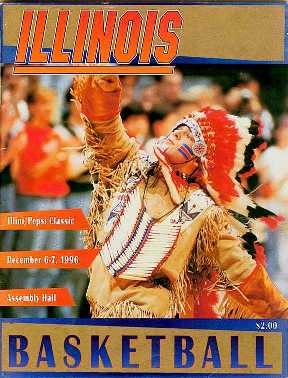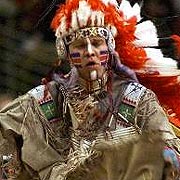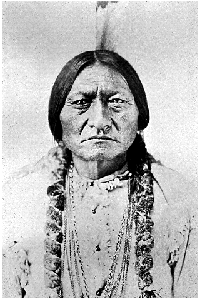 Another Stereotype of the Month entry:
Another Stereotype of the Month entry:
 Another Stereotype of the Month entry:
Another Stereotype of the Month entry:
FORUM
Illiniwek no stereotype, should stay
By Bryan Tolles
April 07, 2005
Last week I was blessed with tickets to the NCAA men's Basketball finals in St. Louis. Although drunk, I noticed something was missing in the halftime show — Chief Illiniwek. In fact, he was missing from the entire NCAA tournament. The Chief's absence spoiled the most important game in the 100-year basketball history of the University of Illinois at Urbana-Champaign. That and North Carolina's brilliant three-point performance.
Overzealous liberals deem the University of Illinois mascot offensive and argue that he must be eliminated. They contend that Chief Illiniwek stereotypes Native Americans. I would understand this if he were to sit mid-court drinking a beer and managing a slot machine. But the history of the Chief and his performance offers a different perspective.
According to a report published by the university's board of trustees, Chief Illiniwek is an almost 80-year-old tradition at Illinois. The Chief's 5-minute halftime show is based on a dance called "fancy dancing," a Native American celebratory dance. The dance has no religious context and is similar to dances performed at Native American dance competitions.
Illiniwek's outfit is handcrafted by the Sioux. It was purchased from Sioux Chief Frank Fools Crow of the Oglala Lakota Sioux from the Pine Ridge Reservation in South Dakota in 1983. So let's not pretend that Chief Illiniwek looks like a cartoon character.
Many universities have changed their Native American mascots, and it is argued that Illinois should do the same. However, this was because these schools treated their mascots as Native American caricatures. Unlike other mascots, the Chief does not take part in any antics on the sideline.
Chief Illiniwek is on the same level as Chief Osceola of the Florida State University Seminoles. Both wear authentic tribal regalia and both perform a short show deriving from a Native American tradition, yet there is little controversy over Osceola. What is it about Chief Illiniwek that is more disturbing than his counterpart Osceola?
I have heard people criticize the Illiniwek name. They find it offensive to name a mascot after a Native American tribe. Illiniwek is a name for the Illinois nation, a group of American Indian tribes. If it is so offensive, then I urge the removal of Peoria and the state of Illinois from all maps.
Illinois officials should consult and cooperate with those knowledgeable of Native American tradition to change any aspects of Illiniwek that are legitimately offensive.
For those insulted by Chief Illiniwek, a goal should be to educate and promote Native American history. How will banning the Chief enlighten others regarding the historical importance of Native Americans?
I challenge the opposition of Chief Illiniwek to use him as an educational tool. Eradication of all Native American symbols in collegiate and professional sports will not change society's perception of them, rather it will eliminate them from our memory.
Last month's Rally Against the "Chief" on the U of I campus brought together forty protesters. According to the rally's organizers, there were speakers supporting the removal of Chief Illiniwek. Sounds like someone is preaching to the choir.


Rob's reply
"Illiniwek no stereotype"? Around here, them's fightin' words...!
He sure as hell is a stereotype. Let me explain how:
For starters, as Tolles himself acknowledges, the chief and his regalia comes from the Oglala Lakota, not from a tribe indigenous to Illinois. Not all tribes had chiefs and not all chiefs wore feather bonnets. Chief Illiniwek perpetuates the big chief stereotype—the idea that all or most tribes were led by a Plains Indian chief.
Tolles has misunderstood the whole idea of stereotyping and why it's bad. An example demonstrates his mistake.
Suppose every sports team named after Indians used a time travel/replicator machine and brought back a copy of Sitting Bull from the past. Let's assume this figure was identical to the original Sitting Bull—essentially, that he was Sitting Bull. Let's further assume that each Sitting Bull replicate volunteered to be the mascot for his sports team.
Because this Sitting Bull was the real McCoy, according to our suppositions, does that mean he wouldn't be stereotypical? No. Sitting Bull didn't wear a headdress often. He was more a political and spiritual leader than a military leader. Most important, he and similar chiefs were only found in the Great Plains region. Indians from other parts of the country (California, New York, Florida, etc.) didn't have chiefs who wore feather bonnets.
The teams that used Sitting Bull as their mascot would be stereotyping the Indians they supposedly represent. They'd be portraying all Indians as if they were Plains Indians..and chiefs...and warlike. They'd ignore the vast diversity of Indian cultures in favor of one clichéd image.
It wouldn't matter that this Sitting Bull was an authentic chief who was dressed appropriately for his tribe and position. He would be an "appropriate" mascot only for a team like him—one located in the Great Plains that focused on spiritual matters and tried to avoid conflicts. Needless to say, no such team exists.
Also, Plains Indian chiefs normally don't do fancy dances—at least not while wearing their regalia. Moreover, I'd bet good money that the mascot's gyrations bear little resemblance to real fancy dancing.
In addition, as the pictures show, Chief Illiniwek sometimes wears face paint. Traditionally, the painted symbols had a meaning, I believe; they weren't just pretty decorations. Moreover, they were worn primarily by warriors going into battle, I believe—not by chiefs who stayed back to guide their tribes. So the paint perpetuates the stereotype that all Indians were warriors who painted their faces in savage designs.
So yes, Chief Illiniwek is stereotypical. Any chief used as a symbol for Indians is stereotypical unless he represents an actual Plains chief. As you can see from this contest, that's rarely the case.
Related links
Team names and mascots
|
. . . |

|
All material © copyright its original owners, except where noted.
Original text and pictures © copyright 2007 by Robert Schmidt.
Copyrighted material is posted under the Fair Use provision of the Copyright Act,
which allows copying for nonprofit educational uses including criticism and commentary.
Comments sent to the publisher become the property of Blue Corn Comics
and may be used in other postings without permission.